Stone Survey Photographer Steps
If you have or would like to volunteer to help us create our digital archive of gravestones, this information is for you. Heck, if you take photos of gravestones anywhere for any purpose, you might find some great tips as well. The photography project is a phase of the Stone Survey.
- Let Us Know
- Sign a Photo Release
- Receive Your Assignment
- Gather Your Supplies
- Go to the Eastern Cemetery and Find Your Stones
- Take Photos of Your Assigned Stones
- Save and Rename Image Files
- Move the Files to Spirits Alive
1. Let Us Know
Please send an email to us and let us know you'd like to start taking photos as part of the project.
2. Sign a Photo Release
The photo release allows us to use the photos in whatever way we need to use them in the future. They are still your photos, and you have the right to do with them as you please. Please fill out the release and mail it to us, or scan and email it to us.
Download the Photo Release (57k PDF)
3. Receive Your Assignment
We will send you an email with:
- List of stones in your assignment
- Details about how to find the stones
- Map of the cemetery section you will be working on
- Link to a folder where you will save your image files
Tip: Bookmark this link or save the email for reference!
4. Gather Your Supplies
Everyone will have a different set of supplies, but this is a basic list to get you started:
- Camera with charged battery
- Extra camera batteries
- Extra memory card
- Mirror or reflector (to move the sunshine where you need it)
- Tripod (especially good to have if you’re by yourself)
- Scissors or grass clippers (to carefully trim around the stone for a clear photo)
- Soft toothbrush or brush (to wipe away dry dirt and grass clippings)
- Water sprayer
- Sun protection
- Insect repellant
- Water
- Stool or bucket (for resting your rear and carrying gear)
- Gloves
- Pen or pencil
- Paper
5. Go to the Eastern Cemetery and Find Your Stones
The Congress Street gates should be open from Memorial Day to Labor Day at around 8am to about 5pm daily by the city park rangers. If you find that isn't the case, Carlson and Turner Books across the street has a key.
Priorities for Working in the Cemetery
- Be respectful. Although we are researchers, we are in a sacred burial ground and want others who happen to see what we are doing to know that we remember it’s a sacred place.
- Do no harm. If anything, we should leave the area in better shape than when we arrived.
- Represent Spirits Alive. We work hard to help others understand the cemetery and let them know that someone is caring for it. You may get a lot of questions from visitors. Please take the time to politely explain you are working with Spirits Alive, and direct them to our email or website if they have questions. We are sanctioned by the city of Portland who owns the property to work in the cemetery.
Find your assigned stones using the clues on your stone list and the map for help.
6. Take Photos of Your Assigned Stones
When you're done with a stone, you'll have a series of images depending on the type. Take notes to keep track of what you’ve taken. Detail photos are not required but are encouraged if the stone has an interesting epitaph, art carving or damage. Context photos are required for each stone.
| Stone Type | Context | Front | Back | Sides | Top | Detail |
|---|---|---|---|---|---|---|
| Head | Yes | Yes | Yes | Yes | ||
| Foot | Yes | Yes | Yes | Yes | ||
| Flat, Ledger, Fallen, Nub | Yes | Yes | ||||
| Monument | Yes | Yes - North, South, East, West | ||||
| Box | Yes | Yes - North, South, East, West | Yes |
Just because a particular angle is not required doesn't mean you can't take the photo. Take as many photos as you would like. Too many images is better than not enough.
Photographing Context
This is a view of the front of the stone with surrounding stones to get an idea of where it is in relation to the area around it. This is required for every stone. Sometimes you can also get the plot marker or plot posts in the photo which is great.
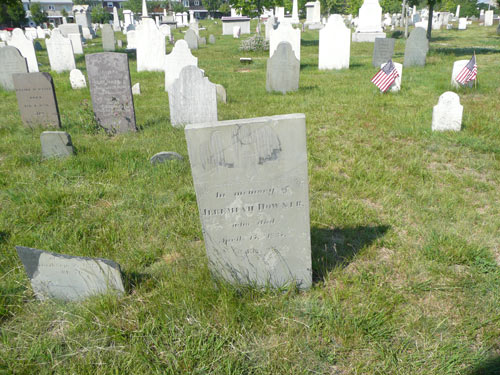
Example of headstone context photo. Note how you can see the stones, or lack thereof, behind it and to the side.
This image would be named b0102headcontext.jpg
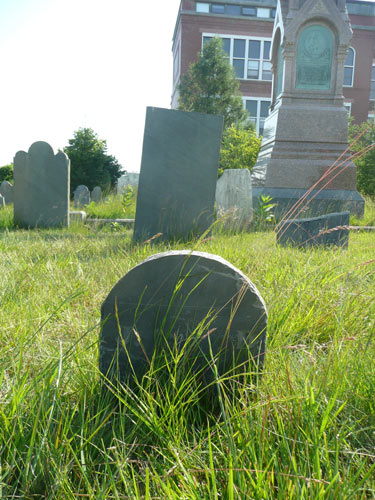
Example of footstone context photo. Note how you can see the headstone behind it. It would have been even better to see the stones or lack thereof on either side.
This image would be named b0102footcontext.jpg
Photographing Front and Back
Fill the frame with the entire stone. If you take a front image, you should have a back image as well. Aim to get the entire surface in the photo and please do not cut off any of the edges.
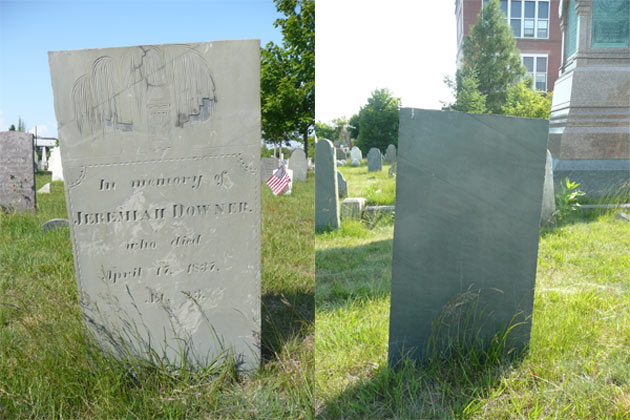
Example of headstone front and back. Notice how the headstone is taking up as much of the view as possible, and no edges have been cut off. The photo of the back could have been taken closer.
These images would be named b0102headfront.jpg and b0102headback.jpg
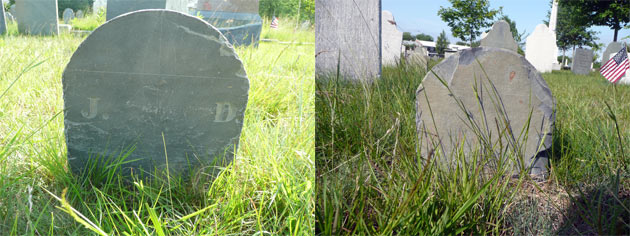
Now look at the front and back of this footstone. Notice how the lighting on one side of the stone is so much better than the other! That's just how it is unless you go in the morning and do all the fronts and then come back in the afternoon to do all the backs. We don't expect anyone to do that.
These images would be named b0102footfront.jpg and b0102footback.jpg
Photographing Sides
At about a 45-degree angle from the front, photos of the side document the condition as well.

This example shows the side of the headstone as well as an angle of the front of the stone.
This image would be named b0102headside1.jpg

Example: a monument should have photos of each of 4 sides like this.
These images would be named a0410monumentnorth.jpg, a0410monumentsouth.jpg, a0410monumenteast.jpg, a0410monumentwest.jpg
Photographing Tops
This only applies to stones that have carving on top, stones that have fallen, flat stones, and ledgers (large flat stones that usually decorate a tomb and are sometimes on top of a box).
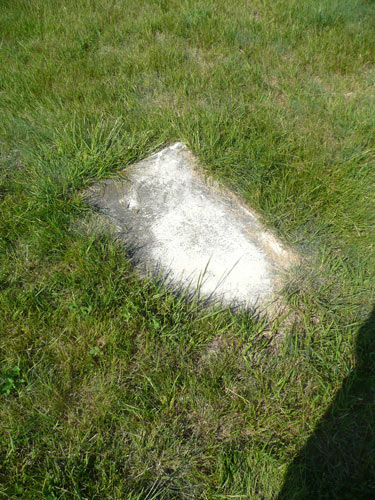
This headstone has fallen, so there will be no front, back and side photos. There will only be context and top.
This image would be named a0705headtop.jpg
Photographing Details
These bonus pictures are not required. If you like the art on a stone, the inscription, or notice damage, you may want to submit a detail. You may like the carving and submit that as well. If you do want to take detail photos, try to get as close up as you can without blurring the image.

If you think it would be nice to have the inscription documented, please do! It's always a help to be able to actually read the text on a stone and to document its wear. If you like the carving or art, it's nice to show that, too.
These images would be named b0102headdetail1.jpg and f124headdetail1.jpg
Camera Settings
Depending on your camera, the settings are set in different ways. You want to make sure you have the highest resolution set to be on the safe side. You do not need a fancy camera — remember that these photos are being taken for a record only — not for art’s sake. The images will be quite large, so expect several megabytes. Consult your owner's manual to make sure you're getting the best quality images.
Basic Stone Photography Tips
There are many resources online to help you with stone photography, and we believe we have pulled the best of them here as they relate to our project. Remember—the photography we are doing is for a record. World-class contest-winning photography is not requested or necessary, so don’t try to emulate Ansel Adams or Daniel Farber.
Rule of thumb: If you can read the stone in person, it would be nice to be able to make out the letters in the photograph.
Lighting
The hardest thing about taking photos of gravestones is knowing the light conditions. Photographs of gravestones are best made in bright sunlight (unless you’re under tree shadows).
The sunlight should fall across from the side or top of the stone at an angle of about 30 degrees. If the sun lights the face of the stone squarely from the front instead of at an angle, the details of the stone's carving will not be clearly delineated. The lighting should cast some shadows, and hopefully bring out hidden details. Most of our stones face westerly, so the afternoon is best.
Reflectors
Sometimes you just can’t be in the cemetery at the right time of day, or the sun changes as you are there for long periods of time. This is when reflectors come in handy! Reflectors change the angle of the light when it isn’t optimal. They also work well when you have good light on the front of the stone, but not the back. Reflector types include:
- Sheet of foil placed over a piece of cardboard (glue foil to it – shiny side out)
- Auto sunshades found wherever auto accessories are sold
- Mirror (you want one the size of the stone if possible so that you can light the entire surface)
- Umbrella (perhaps not a reflector, but a deflector)
With any of these methods, be aware that if the surface of the reflector is not smooth, it could cause unwanted patterns on the stone.

Using a mirror can often help you read a stone that is not being hit with optimal sunlight by reflecting the source of light. For our purposes, this mirror would not be large enough as you can see where it is shining on the stone. It's too small to make a proper photo.
Using a Flash
It's ok to use a flash, but not usually the best solution. Stones are reflective. If you use the flash or shoot directly into the sun, you could get glare spots or (especially on white stones) the flash can wipe out all of the writing on the stone. There's a great illustration of this on this wonderful resource: Guide to Photographing Headstones.
Trimming Grass
It is a good idea to take along some clippers or scissors for cutting grass or brush that might obscure the stone. Be careful not to scratch or damage the stone! Only clip if simply pressing the grass down doesn't work.
Most of the stones in the EC do not to be cleaned for photography purposes, but sometimes there's splashback of dirt after a rain, or grass clippings stuck on from a recent mowing. Use a very soft brush (like a paintbrush or a shaving brush) to take this off.
Wetting a Stone
A trick for getting lettering to stand out is to use a small plant sprayer to finely cover the stone with water. As the water dries off the text, carved areas will remain wet the longest. With luck, the letters will show more clearly as there will be a contrast between the wet and dry surfaces.
These are the only tips and tricks we advocate for reading and photographing gravestones. In the end we ask that you refrain from touching the stones as much as possible. Most of them are 100-200 years old, and many are not in good condition.
7. Save and Rename Image Files
The process is dependent on your camera and computer, but you should move the image files from your camera to your hard drive. Once they are moved, start to rename them.
It’s safest to copy files to your computer so you have them on your camera in case something goes wrong. Once they are saved on your computer, you could delete them from the camera.
How to Rename Image Files
All images should be renamed according to what they are. We use this convention so that the stones will match up to the data in the database. This way we can also tell which stone is in the photo without opening the file.
Stone ID + Stone Type + Angle + Number = b0102headcontext1
- Stone ID emailed to you in the stone list (section letter + row + plot)
- Stone Type head, foot, etc.
- Angle context, front, back, north, south, east, west
- Number 1, 2, etc. (if there is more than one version of a stone type and angle)
Here is an example of how stones are named for one particular person:
| Angle | Stone Type | Name |
|---|---|---|
| Context | head | b0102headcontext.jpg |
| Front | head | b0102headfront.jpg |
| Back | head | b0102headback.jpg |
| Side | head | b0102headside.jpg |
| Detail 1 | head: inscription | b0102headdetail1.jpg |
| Detail 2 | head: urn and willow art | b0102headdetail2.jpg |
| Context | foot | b0102footcontext.jpg |
| Front | foot | b0102footfront.jpg |
| Back | foot | b0102footback.jpg |
How to Rename a Photo without Opening It
- PC Owners
- From “My Computer,” browse to the folder that holds the photography files.
- Right-click a file name.
- This will bring up a menu, and you should scroll down to “RENAME.”
- The file name will give you a cursor, and you can retype the name there.
- Mac Owners
- From “Finder,” browse to the folder that holds the photography files.
- Click on the file name until it is active with a cursor, and retype the file name.
8. Move the Files to Spirits Alive
We are using Google Drive to hold the photo repository. When we receive a signed photo release from you, we will email your first assignment along with the link to your folder on the repository. This is where you will transfer your photos.
- Using the link sent to you with your assignment, go to Google Drive
- Sign in. If you haven't created an account, you'll need to do so.
- Once you have signed in, click the blue button, "Open in Drive."
- Click the button with the red upload with the up-arrow icon in it next to the red "Create" button.
- Choose "Files."
- Browse to where the image files are located on your computer.
- Select the files you want to move.
- Click "Open."
- When prompted, click the blue "Upload and share" button.
- Once the file transfer, or upload, is complete, you may log out and close the window.
- Email us and let us know:
- That you have uploaded your files
- That you would or would not like another assignment
- If you had any trouble: couldn't find stones, forgot to take some shots, couldn't get some shots, found extra stones that weren't on your list, etc.
- Any suggestions or comments about the process
We will move the files from your folder into our archive. If you choose another assignment, we'll email you a new one and the process starts anew!
We would be so grateful and thankful for any help with this project.